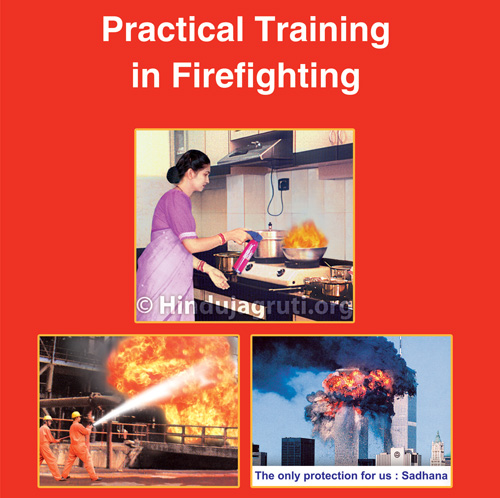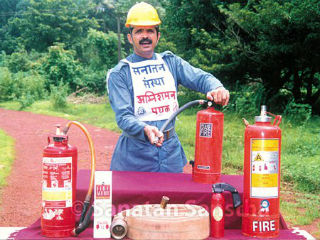
Though fire is an absolutely essential component in our daily life, understanding the thin line between controllable and uncontrollable fires is of great importance. Generally, the fire that man uses is controllable. However, rarely can it become uncontrollable. Firefighters must know what measures to take to control it. Training in firefighting is given in big factories, luxury liners/cruise ships, aeroplanes etc. However, the sad fact is that the average individual and the housewife, who spend 5-6 hours in the kitchen, are completely ignorant about the science of firefighting, and many accidents take place because of this ignorance. The main objective of compiling this Holy text is to explain in simple terms the science underlying fire-fighting, various techniques of firefighting and their benefits, harmful effects arising from using wrong techniques etc.
In a fire accident, there is loss in terms of life as well as property. With the objective of preventing this loss and being successful means participating in the mission of serving national interests and national defence.
Training in firefighting is useful not only during adverse times, but also during normal times. Readers will be introduced to firefighting through this article. Readers should keep this text in their collection.
Practical training in firefighting
1. Introduction
A. Components of fire
Fuel, oxygen and heat are the 3 main components of fire. For creation of fire, not only are these components required to come together, but they should also be in the right proportion.
B. Common causes of fire
1. Natural: Storms, earthquakes, volcanoes etc.
2. Artificial : Man is directly or indirectly responsible for such fires. There are other causes for artificial fires; for example, ignorance (overheating of iron, throwing a cigarette butt carelessly), carelessness, accidents, sabotage, war etc.
C. Classification of fires
Depending on the type of fuel, fires are classified into four types.
1. Class ‘A’ fire : When the combustible substance is solid and carbonaceous such as wood, coal, paper, plastic, rubber etc. it is termed Class ‘A’ fire.
2. Class ‘B’ fire : When the burning substance is liquid or solution of a solid, it is called a Class ‘B’ fire; for example, petrol, diesel, lubricating oil, chemicals, paints etc.
3. Class ‘C’ fire : When the burning substance is in gaseous form or the gaseous form of a liquid, it is called a Class ‘C’ fire; for example, cooking gas, welding gas etc.
4. Class ‘D’ fire : Whenever any metal burns, the fire is said to be Class ‘D’ fire; for example, sodium, potassium, magnesium, titanium etc.
D. What will you do when you see fire ?
1. Caution people in the vicinity by shouting ‘fire-fire’.
2. Inform the fire brigade, Police, municipality about the fire.
3. Till the firefighters arrive, try to keep the fire under control. Shut the doors and windows and switch off the power supply. Shift combustible material in the vicinity of the fire to a safe place. If possible, spray water on the surrounding areas.
4. Extinguish the fire using an appropriate firefighting medium.
E. Techniques of firefighting
1. Starving (Cutting off fuel supply)
When supply of fuel to a fire is cut off, it immediately gets extinguished. This technique is called ‘starving’; for example, when switching off the gas stove, the flame is starved by shutting off the knob.
2. Cooling
When the temperature of the burning substance is lowered below its ignition point, the fire gets extinguished instantly. This technique of firefighting is called ‘cooling’; for example, pouring water over burning wood.

 Practical training in firefighting
Practical training in firefighting Situations and remedial measures in firefighting
Situations and remedial measures in firefighting